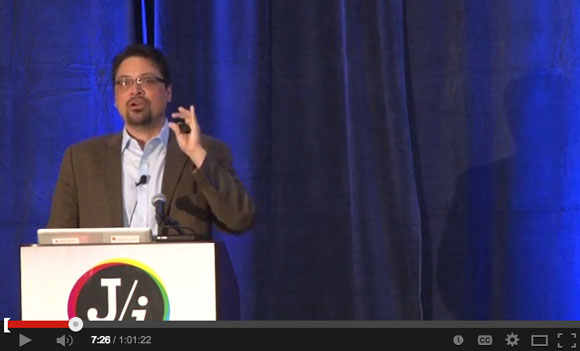14 Takeaways From Journalism Interactive 2014
I made it to my first Journalism Interactive Conference this past weekend. It was held at the University of Maryland and filled with great speakers. While I probably could give you 140 takeaways I left with, here are 14 that jumped out at me (in no particular order — they’re all great).
1. Richard Hernandez’s Presentation Was Packed with Information
I really could give you dozens of takeaways from his presentation alone, but I will spare you all that and I honestly think everyone could get a little something different out of it. The hour-long talk is in the video above and it’s worth every minute. Here are his slides in PDF format that he shared. And here is a great post from American Journalism Review that goes along with his talk “23 Ideas That Could Change the Way You Teach Journalism.”
2. Summer School for Journalism Professors
Amy Webb, founder of the Webb Media Group created and shared with participants a work-on-your-own summer school course aimed at recharging and diving deeper into the world of emerging technology. The 8-week course isn’t a formal course and doesn’t cost anything. It also won’t get you any grad credit, but it should get you some street cred. It looks to help you learn a bit about everything from Reddit and GitHub to mapping and basic programing. I’ve already locked it into my schedule to start June 1. You can find her Slideshare syllabus here.
3. WordPress X Theme
Richard Hernandez showed this theme in his kickoff talk on Friday. It seems to have potential for staffs looking to create some long form stories on subsites. You can check out more about the X theme here.
4. Embed Responsively
Mike Reilley shared a link that that will help create responsive embed code for your site with some simple copying and pasting. Try the site out for yourself. It’s great. I used it for the first time with the Youtube and Vimeo videos in this post. http://embedresponsively.com/
5. Social Search Tools
One of the things I was most impressed with throughout the conference was how much the speakers shared. Joy Mayer of the University of Missouri was no different. She created and shared a Google Document with tools to use for searching social media and the web. The document was great when she shared it, but to make it even more complete she left the document editable so viewers could add more options to the list she created. You can find the document here.
6. Mobile Can’t be Ignored
This isn’t new news, but many of the speakers shared stats and reiterated how fast the mobile market is growing. Student news sites can’t ignore this fact and need to make sure their themes are responsive or mobile friendly and staffs should be creating mobile-friendly content.
7. Google Glass Does Have a Place in the Journalism Classroom
I finally got my hands on a pair of Google Glass and got to try them out. Jeremy Littau of Lehigh University and Mike Reilley of DePaul University had them on hand and were sharing a great deal. On one hand, I saw how they could be used to give first person perspectives to stories and I even saw how they could be used as a teaching tool. The video above is from Chicago Tribune Photojournalist Alex Garcia. He was wearing Google Glass at one of his assignments, took video from Glass while he was on assignment, then went back and narrated what was going through his head at the time. It’s a great perspective and a wonderful teaching tool. Here are a couple other links they shared: http://iamnotaglasshole.com/ and http://glassjournalism.com/
8. iMovie is a Completely Acceptable Mobile Video Editing Application
Whether it was a speaker from Virginia Commonwealth University or an online news editor from Newsday, smart people seem to be happy with iMovie as an editing tool on iOS devices. In some scholastic journalism circles (advisers and students) there is debate of whether iMovie is a good enough tool to edit video on and I hear people “looking to find something better.” I decided once and for all this weekend that if that group gave it a stamp of approval, I can probably not waste any time looking for other apps.
9. Debriefing is Important
I’m going to work to keep poor planning and school bells from allowing this to happen. Jeremy Caplan from the Cuny J-School said that all lesson activities need some debriefing and talked about having debriefing ratios of 1:4 (yes, there was some math at the conference). He talked about using that ratio to setup some time after the activity to help the lesson stick. For instance, if it’s a 20-minute class activity, there should be a 5-minute debrief.
10. Take 5 Minutes to Get to Know Someone
I will not retell this as well as Mikki K. Harris from the University of Mississippi said it during the Teach-A-Thon, but she shared with us her “Moment Exercise.” She talked about how first impressions of people are often negative ones and it often takes us 5 minutes to get to know someone a bit and go from a false impression to a positive one. She said to work with students who are headed out to document someone, to get them to engage the person without a camera for the amount of time they think it takes to get from the false impression. Then, think of words to describe them beyond that first impression and document the subject based off that.
11. You Can’t Do It All, Pick Something
Matt Waite was part of a “Managing Change in Journalism” panel on Saturday morning and during one of his moments with the mic, he talked about how it’s impossible to keep pace with the change so we all need to choose something. He said we need to define a goal and then pick something that will help us get to that goal. To me, it all made a lot of sense. Sometimes I’m just out there wanting to learn things just to learn them (not that that’s a bad thing), but I often don’t have a goal that I’m working toward. I think referring back to this will help focus my energies a bit and make me a better teacher in the long run. It will also make me feel not so bad about feeling like I have to know it all.
12. Shorter is Better
Bethany Swaim from the University of Maryland did an outstanding job with her “Teaching Video” session. A couple stats she gave stuck out to me though. At 10 seconds, 85% of people click away from videos and viewers need a reason to stay every 90 seconds. Great stats to share with my students to get them to start stories strong and keep viewers engaged.
13. Bring People In Instead of Sending Students Out
Another thing I picked up from Swaim was to bring people into your class early on when teaching skills to video students. When people are brought in and students are filming an activity together in class, you as the instructor can see what the students are doing and work to help and correct them as they go. She does this with all levels and talked about one exercise she does where she’s working with students on filming sequences. She brings people in to decorate bite-sized cupcakes and students work to capture sequences of the action taking place. She’s controlling the environment, not leaving so many factors to chance, and she’s on location with each student able to help them as they are learning.
14. I Need to Be Making Changes Each Semester
Sometimes I feel like I do a pretty good job of keeping my classroom assignments fresh and forward-moving. However, after sitting at a conference like this the weekend I realized how much I need to revamp. I see some major reconstruction happening this summer, especially to my intro classes. The foundation of the classes will not change, strong journalism is strong journalism and those skills will still be taught. What will change are just some of the ways I plan to engage and guide the students who enter my room, as well as some of the tools I have them use. I need to give my classes a bit of a 2.0 reboot and this conference gave me the push to do just that.
I have plenty more from the conference I will be sharing in the coming weeks on this site and I’ll be sure to let you all know what changes come as a result of #14.
For those who are interested, Journalism Interactive 2015 will be at the University of Missouri.



